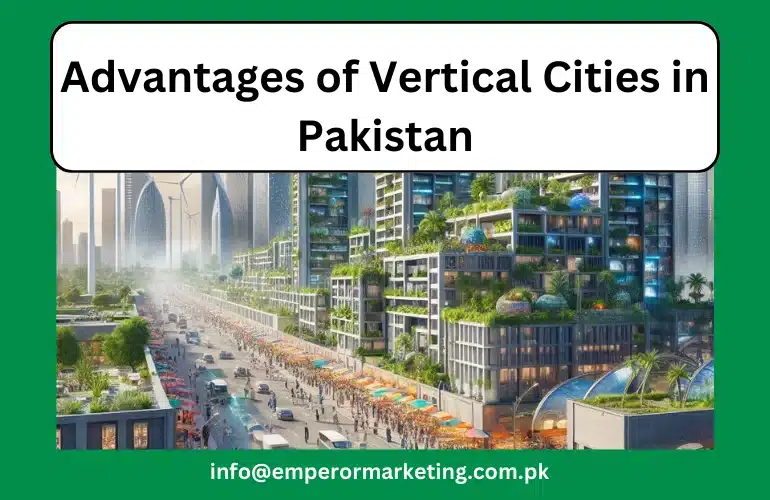As Pakistan’s urban population swells, the need for innovative housing solutions has become more pressing than ever. Vertical cities, characterized by their towering skyscrapers and multi-functional high-rises, are emerging as a viable solution to the growing urban sprawl. This article delves into the numerous advantages of vertical cities in Pakistan by Emperor Marketing, exploring how they can address the country’s housing crisis, improve living standards, and contribute to sustainable urban development.
Efficient Land Use and Urban Density
One of the most significant advantages of vertical cities is their ability to efficiently use limited land. In Pakistan, where urban land is becoming increasingly scarce, vertical construction can accommodate a larger population on a smaller footprint. By building upwards rather than outwards, cities like Karachi, Lahore, and Islamabad can manage their growing populations without expanding horizontally, preserving valuable agricultural land and natural habitats.
Key Points:
- Maximization of land use in densely populated urban centres.
- Preservation of green spaces and natural landscapes.
- Reduction of urban sprawl, leading to more organized city planning.
Sustainable Development and Energy Efficiency
Vertical cities are at the forefront of sustainable urban development. Modern skyscrapers are often designed with energy-efficient systems, including advanced HVAC systems, green roofs, and solar panels, which reduce their overall carbon footprint. In a country like Pakistan, where energy resources are limited, the energy efficiency of vertical cities can contribute significantly to reducing overall energy consumption.
Key Points:
- Green building technologies that reduce energy consumption.
- Integration of renewable energy sources such as solar and wind.
- Lower per capita energy usage due to shared infrastructure.
Improved Infrastructure and Connectivity
Vertical cities promote integrated infrastructure development, where residential, commercial, and recreational spaces are all close. This reduces the need for long commutes, easing traffic congestion and lowering pollution levels. In Pakistan, where urban mobility is a significant challenge, vertical cities offer a solution by creating self-sustained communities with easy access to essential services.
Key Points:
- Mixed-use developments that combine living, working, and leisure spaces.
- Reduced traffic congestion due to decreased reliance on cars.
- Enhanced public transportation networks connected to high-rise hubs.
Economic Growth and Job Creation
The construction and maintenance of vertical cities provide substantial opportunities for economic growth and job creation. The real estate, construction, and service industries all benefit from the development of high-rise buildings. In Pakistan, where unemployment is a concern, the construction of vertical cities can provide jobs for thousands of workers, from architects and engineers to labourers and service staff.
Key Points:
- Boost to the construction industry, leading to economic growth.
- Creating jobs in various sectors, including real estate, maintenance, and services.
- Attraction of foreign investment in Pakistan’s urban development projects.
Enhanced Quality of Life
Vertical cities offer a higher quality of life by providing residents with modern amenities, security, and a sense of community. These buildings often include gyms, swimming pools, shopping centres, and parks, all within the same complex. In Pakistan, where access to such amenities is usually limited in traditional housing areas, vertical cities can significantly improve the living standards of urban dwellers.
Key Points:
- Access to amenities like fitness centres, shopping malls, and recreational spaces.
- Improved security with 24/7 surveillance and controlled access.
- Community living that fosters social interaction and collaboration.
Environmental Benefits
Vertical cities contribute to environmental sustainability by reducing the urban heat island effect and promoting green architecture. High-rise buildings can be designed with eco-friendly materials, energy-efficient systems, and green spaces that help mitigate the environmental impact of urbanization. In Pakistan, where ecological degradation is a growing concern, vertical cities offer a path towards more sustainable urban living.
Key Points:
- Reduction in the urban heat island effect through green roofs and vertical gardens.
- Use of eco-friendly building materials that minimize environmental impact.
- Promotion of urban agriculture within high-rise communities.
Addressing Housing Shortages
Pakistan is currently facing a severe housing shortage, with millions of people lacking adequate shelter. Vertical cities can play a crucial role in addressing this issue by providing affordable and efficient housing solutions. By utilizing limited land resources more effectively, vertical construction can help bridge the gap between supply and demand in the housing market.
Key Points:
- Affordable housing solutions that cater to a growing population.
- Efficient use of space to accommodate more residents in urban areas.
- Potential to reduce homelessness and improve living conditions for low-income families.
Conclusion
The advantages of vertical cities in Pakistan are clear. From efficient land use and sustainable development to economic growth and improved quality of life, vertical cities offer a comprehensive solution to many of the challenges faced by urban centres in the country. As Pakistan continues to urbanize, embracing the concept of vertical cities could be vital to ensuring a prosperous, sustainable, and inclusive future for all its citizens.

